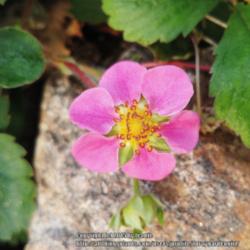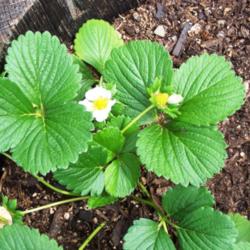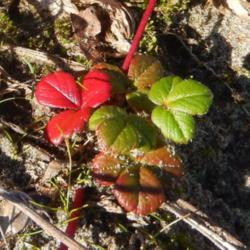Native in the Pacific NW and throughout North America. Found in moist woods, stream banks, and sandy meadows from low to mid elevations.

A happy-go-lucky little groundcover. Does well in sun to part-shade. Sends off shoots readily to multiply, and is easy to transplant. I like this at the front of beds, extending as far as they will go under shrubs and taller perennials. It makes a nice bright statement in full spring bloom, then continues to flower sporadically throughout summer. The teeny little berries are rather insipid, but the birds (and chickens) like them. Makes a nice pairing with http://allthingsplants.com/plants/view/81512/Pacific-Bleeding-Heart-Dicentra-formosa/ as a companion ground cover that is more shade tolerant and will stay farther back in the bed.

This is one of the parent plants for the cultivated hybrid strawberry. The root system forms a symbiotic relationship with certain bacteria in the soil.

Easy to grow from seeds. Some only take 1 year or less than a year from seeds to flower and fruit. This variety is not as crazy as the regular red Alpine strawberry. This fruit's taste reminds me much more of pineapple than strawberry.

One year I got three new varieties of strawberries to try at once: Seascape, Mara des Bois , and Honeoye. After a couple of years I kept Honeoye and removed the other two. Seascape is not June bearing, so I wasn't expecting large numbers of berries, just small amounts throughout the season. But, the plants were not very vigorous and the fruit was quite small, round, and not very appetizing looking. The flavor was bland without much sweetness and juiciness. They were well reviewed by others, but perhaps these just don't perform well in my climate or soil. I have also read that the June-bearers like Honeoye just have better flavor in general, so maybe that is why I didn't like the other two.

This is my favorite strawberry I've grown so far. The fruits are juicy, sweet, fairly uniform in size and shape, and red and fleshy to the center. They are vigorous and make good runners. The flavor easily beat out the two ever-bearing varieties I tried - Seascape and Mara des Bois. Honeoye had a slight edge over the June-bearer Cavendish, which sometimes produced over-sized fruit with empty spaces and a lot of white inside. The only bad comment I have about Honeoye is the name.... how the heck is it pronounced! Every time I try to say it I look stupid, and when I write it I have to double check that I did it right.

June bearing.

Native in the Pacific Northwest, found in sand dunes and sea bluffs. Each plant will quickly multiply by runners to form a solid groundcover. As with all strawberries, the best vigor is from young plants so it is good to thin out the oldest plants occasionally. The fruit is attractive to birds, deer, racoons, squirrels, and other wildlife. It can be made into jams or simply eaten out of hand. The shiny leaves may be made into a tea for diarrhea, or crushed and applied as a poultice for burns.

A cross between the Native wild strawberry (Fragaria virginiana,) and a Chilean native (Fragaria chiloensis). They are small-fruited everbearing plants. Larger than a wild strawberry but smaller than common varieties of red strawberries. Culture is the same, although interplanting with red strawberries will increase yield. Often sold as pineberries due to their unique flavor, which is reminiscent of pineapple.

One year I got three new varieties of strawberries to try at once: Seascape, Mara des Bois , and Honeoye. After a couple of years I kept Honeoye and removed the other two. Mara des Bois was supposed to be THE strawberry to try with rave reviews talking about complex flavors. It definitely tasted different, but it was not a flavor anyone I gave it to particularly liked. I found it to have a pretty strong floral taste that I did not like. It was like eating a strawberry while smelling perfume. It seemed to do all right production-wise for an ever-bearing variety, but nobody really wanted to eat them unless they were mixed in with other berries to dilute the "perfume" like scent.
